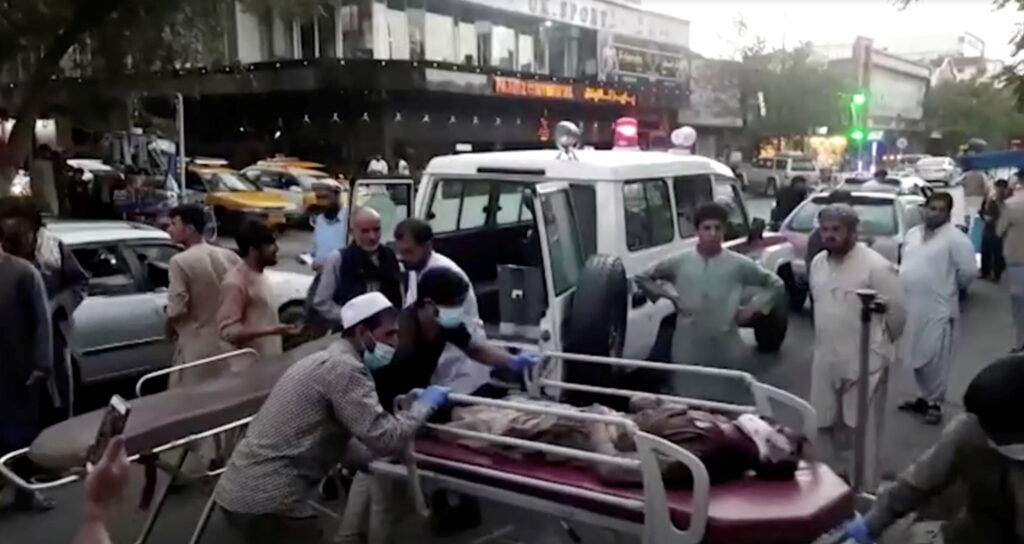Who Are the Islamic State in Afghanistan?
CENTRAL ASIA, 30 Aug 2021
Anatol Lieven | Responsible Statecraft – TRANSCEND Media Service
26 Aug 2021 – Today’s ghastly bombings reflect a real threat to the Taliban’s new-found control over the country — and to the U.S. evacuation on the ground.

A screen grab shows people carrying an injured person to a hospital after an attack at Kabul airport, Afghanistan August 26, 2021. REUTERS TV/1TV/Handout via Reuters. This image has been supplied by a third party. Mandatory credit. No resales. No archives. Afghanistan out. No commercial or editorial sales in Afghanistan.
The ghastly bombings at Kabul airport Thursday [26 Aug] resulting in the deaths of 12 U.S. Marines and as of this writing, 60 civilians, are the latest in a series of especially savage terrorist attacks reportedly by the Islamic State of Khorasan Province (ISKP), the local affiliate of the Islamic State of the Middle East. The growth of ISKP faces the Taliban rulers of Afghanistan with both a threat and an opportunity.
The threat is that ISKP will attract enough Taliban defectors and foreign fighters to cause serious instability and ruin the hopes of pragmatic Taliban leaders for economic development. The opportunity lies in the fact that ISKP are feared by every government in Afghanistan’s region, as well as the United States and Europe. This gives the Afghan Taliban the chance to attract support from all of these states in their fight against ISKP.
ISKP appeared in Afghanistan and the border areas of Pakistan in 2014-15. It was founded not by Arabs sent from the Middle East (though some moved to Afghanistan later after the defeat of IS in Iraq and Syria) but by local figures and groups who adopted the name of the Islamic State to garner some of its prestige and to reflect their own international jihadi allegiance (just as previously, local groups in north Africa and elsewhere took the name of al- Qaida).
Since then, ISKP have emerged as a distinctly more ferocious and radical force than the mainstream Taliban, carrying out savage attacks on targets that in recent years the Taliban leadership have made a deliberate political decision to spare: especially schools, clinics and markets serving the Shia minority. The Taliban leadership have strongly condemned these attacks, although some analysts accuse the Taliban of benefiting from plausible deniability. In alliance with Pakistani terrorist groups, they have also conducted several major terrorist attacks within Pakistan.
In Afghanistan, ISKP have fought pitched battles against the Taliban for local power. When I visited Nangrahar province on the Pakistani border in 2017, I was told of an operation earlier that year in which the Taliban, the Afghan National Army, and the U.S. Air Force had engaged in de facto cooperation against them.
The key difference between the Afghan Taliban and ISKP lies in their substantially different national origins. The Taliban have links to international jihadi groups including al-Qaida; but the entire Taliban leadership, and the overwhelming majority of its troops, are Afghans (and chiefly Afghan Pashtuns). They embody a strong sense of Afghan nationalism, and the pragmatists among them see themselves as the heirs (in a specifically Shariah-based way) of the history of Pashtun state-building in Afghanistan.
ISKP by contrast largely took shape in 2014-15 among Pakistani Pashtun Islamist rebels against Pakistan who were driven to seek refuge among their fellow Pashtuns of eastern Afghanistan by the successful counter-insurgency campaigns of the Pakistan Army. The first Emir of ISKP, Hafiz Saeed Khan (Killed by a U.S. airstrike in 2016), was also a leader of the Pakistani Taliban. One source of deep ISKP bitterness against the Afghan Taliban has been that the Taliban refused to support their Pakistani brethren in their rebellion — for the very good reason that the Afghan Taliban depended heavily on the Pakistani state and army for shelter.
A second major element in ISKP membership is made up of Islamist fighters from a range of failed Islamist revolts in the former USSR who took refuge in Afghanistan over the past generation; notably Uzbeks linked to the Islamic Movement of Uzbekistan and Chechens, Daghestanis, and others from the North Caucasian rebellions against Russia. To these can be added a certain number of anti-Chinese Uighur militants from Sinkiang.
As in Iraq and Syria, Arab members of Al-Qaida in Afghanistan and the border areas of Pakistan have also joined ISKP. With the Taliban leadership over the past decade repeatedly declaring that it was not an international jihadi force and would not support international jihad, those international fighters who hoped one day to renew jihad in their homelands naturally gravitated to ISKP.
Coming from outside Afghanistan (though in the case of the Pakistanis, of the same Pashtun ethnicity as the Afghan Taliban), these elements of ISKP do not pose much of a threat to the stability of Afghan Taliban rule. The third element is much more dangerous. This is made up of Afghan defectors from the Taliban. Their motives for leaving the Taliban for ISKP are various, and it is very hard to say in individual cases which one predominated.
Some local commanders and fighters who joined ISKP have been ideological hardliners infuriated with the Taliban leadership’s negotiations with the Americans, Russians, and Iranians and renunciation of international jihad. Some became involved in local feuds with other Taliban commanders or were disappointed not to receive local positions of authority from the Taliban.
The danger for the Taliban lies in the fact that all these impulses to defect to ISKP may increase as a result of the Taliban’s conquest of government. Rigid ideologues will be outraged if the Taliban leadership keep any (let alone all) of their promises to include non-Taliban figures from the previous regime in government, to continue women’s education, and so on. Sunni sectarian extremists (possibly backed covertly by Saudi Arabia) will be outraged if the Taliban leadership keep their promises to Iran to respect Shia minority rights. Many local commanders will be disappointed not to receive the government positions they had expected. And if the Taliban keep their promise to suppress the heroin trade, then they can expect resistance from some of their own commanders and followers who have profited from that trade.
The Taliban will be using all of this in their appeals for international aid, especially from China, Russia, and the West, to strengthen their government against ISKP; while ISKP on the other hand will seek by further terrorist attacks to destabilize Afghanistan, prevent economic growth and eventually bring down Taliban rule and turn Afghanistan into a base for international jihad. They will doubtless focus their attacks above all on their traditional objects of hatred: Shia; Western, Russian, and Chinese offices, NGOs and individuals; westernized Afghans; and institutions of learning.
As they have demonstrated by their reported bombings at Kabul airport, ISKP can cause dreadful suffering. In terms of a struggle for power however the odds are heavily on the side of the Taliban. ISKP is a dangerous terrorist force whose attacks increased threefold from 2020-21, but a relatively small military force (estimates today are of around 2,000 ISKP fighters). The Taliban now control the central government (or whatever is left of it) and have captured enormous stocks of U.S.-supplied weapons, ammunition, and vehicles from the Afghan National Army. They have the prestige that comes from their long struggle and their stunning victory. And perhaps most important of all, in their fight with ISKP, the Taliban will have the support of every country in the region — though only as long as they keep to their own promises not to support international terrorism, to suppress heroin, and to respect Shia rights.
Or at least, so it seems at present; but it would be unwise to forget that every attempt to create an effective state in Afghanistan over the past 100 years has failed from a combination of social and religious conservatism, social fissures, kinship and ethnic loyalties, corruption, lack of education, limited state resources, and sheer poverty. The Taliban are now making yet another attempt. It is likely to be a long time before we will be able to judge how successful they have been.
_________________________________________
 Anatol Lieven is senior research fellow on Russia and Europe at the Quincy Institute for Responsible Statecraft. He was formerly a professor at Georgetown University in Qatar and in the War Studies Department of King’s College London. He is a member of the academic board of the Valdai discussion club in Russia, and a member of the advisory committee of the South Asia Department of the British Foreign and Commonwealth Office. He holds a BA and PhD from Cambridge University in England.
Anatol Lieven is senior research fellow on Russia and Europe at the Quincy Institute for Responsible Statecraft. He was formerly a professor at Georgetown University in Qatar and in the War Studies Department of King’s College London. He is a member of the academic board of the Valdai discussion club in Russia, and a member of the advisory committee of the South Asia Department of the British Foreign and Commonwealth Office. He holds a BA and PhD from Cambridge University in England.
Tags: Afghanistan, CIA, Central Asia, Drones, Geopolitics, Hegemony, Human Rights, Imperialism, International Relations, NATO, Occupation, Pentagon, State Terrorism, Taliban, UK, US Military, USA, Violence, War on Terror, Warfare
DISCLAIMER: The statements, views and opinions expressed in pieces republished here are solely those of the authors and do not necessarily represent those of TMS. In accordance with title 17 U.S.C. section 107, this material is distributed without profit to those who have expressed a prior interest in receiving the included information for research and educational purposes. TMS has no affiliation whatsoever with the originator of this article nor is TMS endorsed or sponsored by the originator. “GO TO ORIGINAL” links are provided as a convenience to our readers and allow for verification of authenticity. However, as originating pages are often updated by their originating host sites, the versions posted may not match the versions our readers view when clicking the “GO TO ORIGINAL” links. This site contains copyrighted material the use of which has not always been specifically authorized by the copyright owner. We are making such material available in our efforts to advance understanding of environmental, political, human rights, economic, democracy, scientific, and social justice issues, etc. We believe this constitutes a ‘fair use’ of any such copyrighted material as provided for in section 107 of the US Copyright Law. In accordance with Title 17 U.S.C. Section 107, the material on this site is distributed without profit to those who have expressed a prior interest in receiving the included information for research and educational purposes. For more information go to: http://www.law.cornell.edu/uscode/17/107.shtml. If you wish to use copyrighted material from this site for purposes of your own that go beyond ‘fair use’, you must obtain permission from the copyright owner.